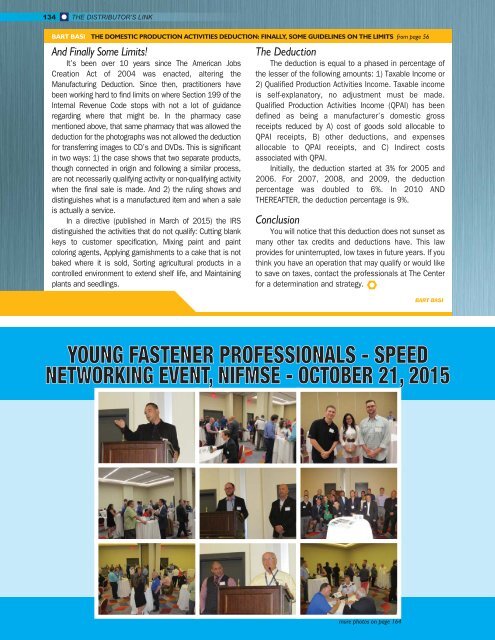WINTER 2016
Distributor's Link Magazine Winter Issue 2016 / Vol 39 No1
Distributor's Link Magazine Winter Issue 2016 / Vol 39 No1
You also want an ePaper? Increase the reach of your titles
YUMPU automatically turns print PDFs into web optimized ePapers that Google loves.
134 THE DISTRIBUTOR’S LINK<br />
BART BASI THE DOMESTIC PRODUCTION ACTIVITIES DEDUCTION: FINALLY, SOME GUIDELINES ON THE LIMITS from page 56<br />
And Finally Some Limits!<br />
It’s been over 10 years since The American Jobs<br />
Creation Act of 2004 was enacted, altering the<br />
Manufacturing Deduction. Since then, practitioners have<br />
been working hard to find limits on where Section 199 of the<br />
Internal Revenue Code stops with not a lot of guidance<br />
regarding where that might be. In the pharmacy case<br />
mentioned above, that same pharmacy that was allowed the<br />
deduction for the photographs was not allowed the deduction<br />
for transferring images to CD’s and DVDs. This is significant<br />
in two ways: 1) the case shows that two separate products,<br />
though connected in origin and following a similar process,<br />
are not necessarily qualifying activity or non-qualifying activity<br />
when the final sale is made. And 2) the ruling shows and<br />
distinguishes what is a manufactured item and when a sale<br />
is actually a service.<br />
In a directive (published in March of 2015) the IRS<br />
distinguished the activities that do not qualify: Cutting blank<br />
keys to customer specification, Mixing paint and paint<br />
coloring agents, Applying garnishments to a cake that is not<br />
baked where it is sold, Sorting agricultural products in a<br />
controlled environment to extend shelf life, and Maintaining<br />
plants and seedlings.<br />
The Deduction<br />
The deduction is equal to a phased in percentage of<br />
the lesser of the following amounts: 1) Taxable Income or<br />
2) Qualified Production Activities Income. Taxable income<br />
is self-explanatory, no adjustment must be made.<br />
Qualified Production Activities Income (QPAI) has been<br />
defined as being a manufacturer’s domestic gross<br />
receipts reduced by A) cost of goods sold allocable to<br />
QPAI receipts, B) other deductions, and expenses<br />
allocable to QPAI receipts, and C) Indirect costs<br />
associated with QPAI.<br />
Initially, the deduction started at 3% for 2005 and<br />
2006. For 2007, 2008, and 2009, the deduction<br />
percentage was doubled to 6%. In 2010 AND<br />
THEREAFTER, the deduction percentage is 9%.<br />
Conclusion<br />
You will notice that this deduction does not sunset as<br />
many other tax credits and deductions have. This law<br />
provides for uninterrupted, low taxes in future years. If you<br />
think you have an operation that may qualify or would like<br />
to save on taxes, contact the professionals at The Center<br />
for a determination and strategy.<br />
BART BASI<br />
YOUNG FASTENER PROFESSIONALS - SPEED<br />
NETWORKING EVENT, NIFMSE - OCTOBER 21, 2015<br />
more photos on page 164

















